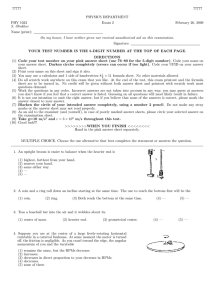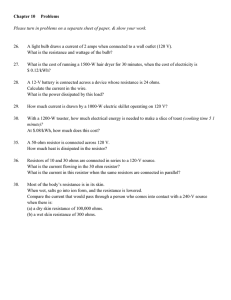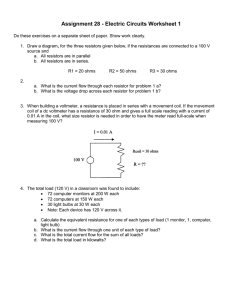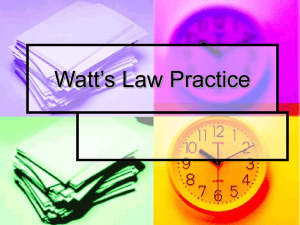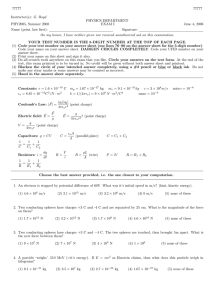Science Problems for Calculus I Jim Belk Bard College
advertisement
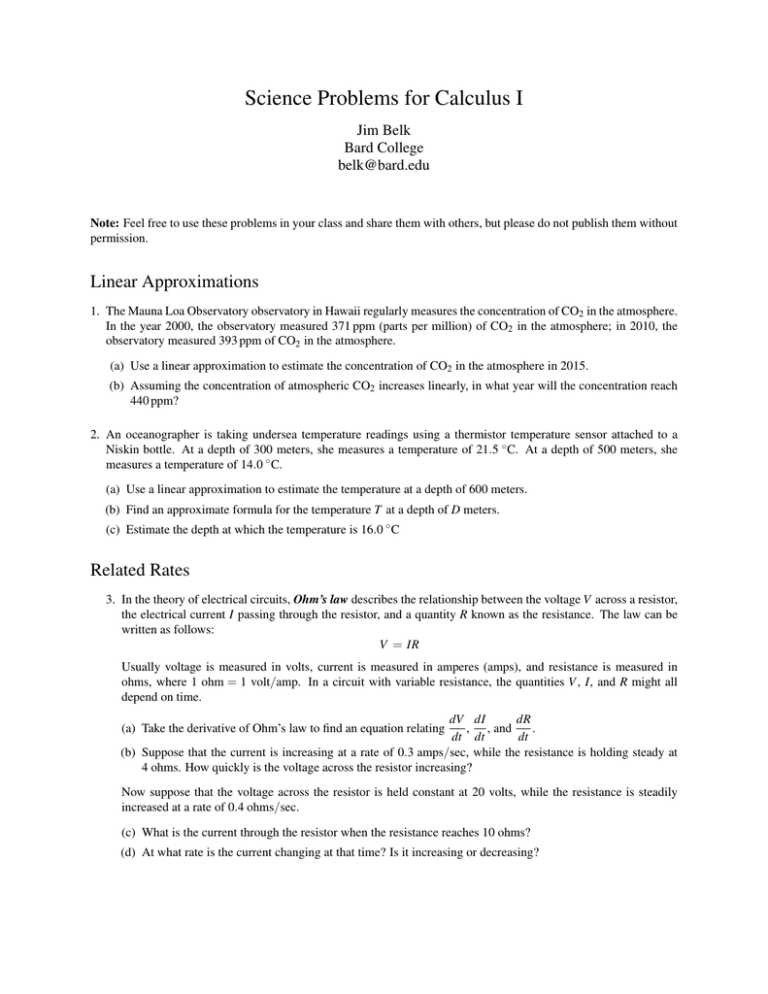
Science Problems for Calculus I Jim Belk Bard College belk@bard.edu Note: Feel free to use these problems in your class and share them with others, but please do not publish them without permission. Linear Approximations 1. The Mauna Loa Observatory observatory in Hawaii regularly measures the concentration of CO2 in the atmosphere. In the year 2000, the observatory measured 371 ppm (parts per million) of CO2 in the atmosphere; in 2010, the observatory measured 393 ppm of CO2 in the atmosphere. (a) Use a linear approximation to estimate the concentration of CO2 in the atmosphere in 2015. (b) Assuming the concentration of atmospheric CO2 increases linearly, in what year will the concentration reach 440 ppm? 2. An oceanographer is taking undersea temperature readings using a thermistor temperature sensor attached to a Niskin bottle. At a depth of 300 meters, she measures a temperature of 21.5 ◦ C. At a depth of 500 meters, she measures a temperature of 14.0 ◦ C. (a) Use a linear approximation to estimate the temperature at a depth of 600 meters. (b) Find an approximate formula for the temperature T at a depth of D meters. (c) Estimate the depth at which the temperature is 16.0 ◦ C Related Rates 3. In the theory of electrical circuits, Ohm’s law describes the relationship between the voltage V across a resistor, the electrical current I passing through the resistor, and a quantity R known as the resistance. The law can be written as follows: V = IR Usually voltage is measured in volts, current is measured in amperes (amps), and resistance is measured in ohms, where 1 ohm = 1 volt/amp. In a circuit with variable resistance, the quantities V , I, and R might all depend on time. dV dI dR , , and . dt dt dt (b) Suppose that the current is increasing at a rate of 0.3 amps/sec, while the resistance is holding steady at 4 ohms. How quickly is the voltage across the resistor increasing? (a) Take the derivative of Ohm’s law to find an equation relating Now suppose that the voltage across the resistor is held constant at 20 volts, while the resistance is steadily increased at a rate of 0.4 ohms/sec. (c) What is the current through the resistor when the resistance reaches 10 ohms? (d) At what rate is the current changing at that time? Is it increasing or decreasing? 4. When expanding adiabatically (i.e. without gaining or losing heat), the pressure P and volume V of a sample of argon gas are related by the formula PV 5/3 = constant. dV dP and . dt dt (b) Suppose the volume of the sample is increasing at a rate of 0.4 L/s. How quickly is the pressure decreasing when the volume is 2.7 L and the pressure is 80 kPa? (a) Take the derivative of the above equation to find a formula relating P, V , 5. A positively charged particle is flying in the vicinity of a charged conductor. The electric potential energy of the particle is given by the formula qQ E = ke , r where q is the charge of the particle, Q is the charge on the conductor, r is the distance between them, and ke = 0.90 cm · J/µC2 . dr dE in terms of q, Q, ke , r and . dt dt (b) At a certain instant, a particle with a charge of 1.5 µC is 20 cm away from a conductor, and is flying directly towards the conductor at a rate of 2.0 cm/s. Given that the conductor has a charge of 4.0 µC, how quickly is the electrical potential energy of the particle increasing? (a) Assuming q and Q are constant, find a formula for 6. In physics, the energy stored in a stretched spring is determined by the equation E = 1 2 kx , 2 where E is the energy, k is a constant (the spring constant), and x represents the distance that the spring has been stretched. (a) Find a formula for dE dx in terms of k, x, and . dt dt (b) A spring with spring constant k = 0.20 Joules/cm2 is being stretched at a rate of 1.5 cm/sec. How quickly is the energy stored in the spring increasing at the moment that x = 10 cm? 7. In chemistry and physics, Boyle’s Law describes the relationship between the pressure and volume of a fixed quantity of gas maintained at a constant temperature. The law states that: PV = a constant where P is the pressure of the gas, and V is the volume. (a) Take the derivative of Boyle’s law to find an equation relating dP dV , , P, and V . dt dt (b) A sample of gas is placed in a cylindrical piston. At the beginning of the experiment, the gas occupies a volume of 250 cm3 , and has a pressure of 100 kPa. The piston is slowly compressed, decreasing the volume of the gas at a rate of 50 cm3 /min. How quickly will the pressure of the gas initially increase? 8. In physics, the kinetic energy of a moving object is given by the formula K= 1 2 mv 2 where m is the mass and v is the velocity. Suppose an object with a mass of 2.00 kg is accelerating at a rate of 6.00 m/s2 . How quickly is the kinetic energy of the object increasing when the velocity is 23.0 m/s? 9. In the theory of electrical circuits, Joule’s law describes a relationship between the power P dissipated by a resistor, the electrical current I passing through the resistor, and the resistance R. The law can be written as follows: P = I 2 R. Usually power is measured in watts, current is measured in amps, and resistance is measured in ohms, where 1 ohm = 1 watt/amp2 . dI dR dP in terms of I, R, , and . dt dt dt (b) Suppose that the current through a resistor is increasing at a rate of 0.04 amps/sec, while the resistance is increasing at a rate of 5 ohms/sec. How quickly is the power dissipated by the resistor increasing when the current is 0.3 amps and the resistance is 60 ohms? (a) Find an equation for 10. The ideal gas law relates the temperature, pressure, and volume of an ideal gas. Given one mole of gas, the pressure P, volume V , and temperature T are related by the equation PV = R T where R is the molar gas constant (R ≈ 8.314 kPa · liters/kelvin). (a) Suppose that one mole of ideal gas is held in a closed container with a volume of 25 liters. If the temperature of the gas is increased at a rate of 3.5 kelvin/min, how quickly will the pressure increase? (b) Suppose instead that the temperature of the gas is held fixed at 300 kelvin, while the volume decreases at a rate of 2.0 liters/min. How quickly is the pressure of the gas increasing at the instant that the volume is 20 liters? Logarithms 11. The human ear is sensitive to an amazing range of sound levels. For example, the sound emitted by a jackhammer is equivalent in magnitude to about 100,000 human voices, while a single human voice is approximately as loud as 100,000 buzzing mosquitoes. In terms of power, a jackhammer emits about 1 watt of sonic energy, a human voice emits about 0.00001 watts, and a buzzing mosquito emits about 0.0000000001 (or 10−10 ) watts. For this reason, the “loudness” of a sound is usually described in terms of decibels, which are a logarithmic unit. The decibel level L of a sound is related to the power P according to the formula P L = 10 log P0 where P0 = 10−12 watts. (The constant P0 represents the softest sound audible to human ears.) (a) Based on the information above, find the decibel levels of the sounds emitted by a jackhammer, a human voice, and a buzzing mosquito. (b) What is the decibel level of a sound having power P0 ? (c) Make a table showing the decibel levels for sounds having powers of 0.00001 watts, 0.0001 watts, 0.001 watts, 0.01 watts, 0.1 watts, 1 watt, 10 watts, and 100 watts. (d) If the power of a sound is doubled (say, by having two jackhammers instead of one), how much does the decibel level increase? (e) The band Disaster Area wants to make an awesome 160 decibels of sound at their next rock concert. (They want to be able to brag that they are “as loud as a jet engine”.) Unfortunately, no legally available speaker can emit more than 145 decibels of sound. How many speakers will they need? 12. In astronomy, the apparent magnitude is a logarithmic measure of the brightness of a star as seen by an observer on Earth. The apparent magnitude M of a star is related to the brightness B of the observed light by the formula B M = −1.09 ln B0 where B0 = 2.13 × 10−6 lux. Note that brighter stars have smaller apparent magnitudes. (a) As seen from Earth, the star Polaris (the North Star) has a brightness of 3.5 × 10−7 lux. What is the apparent magnitude of Polaris? (b) The brightest star in the night sky is Sirius, with an apparent magnitude of −1.47. What is the brightness of the light that the Earth receives from this star? (c) To an observer on Earth, the sun is approximately 12 billion times as bright as Sirius. What is the apparent magnitude of the sun? dM dB (d) Find a formula relating and . dt dt (e) The apparent magnitude of the variable star Delta Cephei oscillates regularly over the course of several days. At a certain time, the apparent magnitude of Delta Cephei is 3.90, and the magnitude is decreasing at a rate of 0.010/ hour. How quickly is the brightness of the star increasing? 13. In chemistry, the pH of a solution is defined by the formula pH = −0.4343 ln(a), where a is the hydrogen ion activity. (a) Suppose the hydrogen ion activity of a solution is increasing at a rate of 0.003/min. How quickly is the pH decreasing when the hydrogen ion activity is 0.02? (b) Suppose instead that the pH of a solution is increasing at a rate of 0.5/min. How quickly is the hydrogen ion activity decreasing when the pH is 2.5? Exponential Growth 14. At the beginning of a biology experiment, a culture of E. coli bacteria has a population of 6,000. Ten minutes later, the population has increased to 9,300. (a) What was the percentage increase in the population of E. coli over the first ten minutes? (b) Assuming exponential growth, make a table showing the population of E. coli after 20 minutes, 30 minutes, 40 minutes, 50 minutes, and 60 minutes. (c) Use the following axes to sketch a graph of the E. coli population during the first hour of the experiment. FINAL ANSWER 100k 80k 80k Population Population PRACTICE SPACE 100k 60k 40k 20k 0 60k 40k 20k 0 10 20 30 40 Time Hmin.L 50 60 0 0 10 20 30 40 Time Hmin.L 50 60 (d) Suppose the bacteria continue to grow exponentially for five hours. Make a table showing the population of E. coli at the end of each hour. (e) Use the following axes to sketch a logarithmic plot of the E. coli population over the course of five hours. PRACTICE SPACE 1b 100m 100 m 10m 1m 10 m 1m 100k 100 k 10k 10 k 1k 0 1 2 3 Time HhoursL FINAL ANSWER 10 b 1b Population Population 10b 4 1k 5 0 1 2 3 Time HhoursL 4 5 (f) Assuming exponential growth, the population P should obey the formula P = b ekt where t is the time in minutes, and b and k are constants. What are the values of b and k? (g) The generation time of a bacterial culture is length of time required for the population to double. What is the generation time of this E. coli culture? Your answer must be correct to two decimal places. dP (h) Find a formula for as a function of t. dt (i) Based on your answer to part (h), how quickly was the population increasing at the very beginning of the experiment? 15. As part of a chemistry experiment, 0.250 moles of butyl chloride (C4 H9 Cl) are dissolved in water. The butyl chloride reacts with the water, producing butyl alcohol and hydrochloric acid. Initially, this reaction consumes butyl chloride at a rate of 0.030 moles/min. Let t be the time in minutes, and let n be the number of moles of butyl chloride remaining. (a) Assuming that n decays exponentially, find a formula for n in terms of t. (b) How much butyl chloride will remain after 10 minutes? (c) How quickly is the butyl chloride being consumed at this time? (d) How long will it take for 95% of the butyl chloride to be consumed? 16. A chemist prepares a 100-mg sample of 210 Po. Because of radioactive decay, the mass of the sample after one day is only 99.5 mg. (a) Find a formula for the mass of the sample after x days. (b) How long will it take for the mass of the sample to reach 50 mg? Round your answer to the nearest day. 17. A capacitor holds 20.0 mC of electric charge. The capacitor is attached to a light bulb, and charge begins to flow out of it at a rate of 0.4 mC/sec. (a) Assuming the charge left in the capacitor decays exponentially, find a formula for the charge Q left in the capacitor after t seconds. (b) How long will it take for half of the charge in the capacitor to be expended? 18. When heated, gaseous azomethane decomposes into nitrogen gas and ethane: C2 H6 N2 −→ N2 + C2 H6 In a certain chemistry experiment, a 2.00-gram sample of azomethane is heated to a temperature of 600 K, and it begins to decompose. The initial rate of decomposition is measured to be approximately 2.60 grams/hour. (a) Assuming the mass of the azomethane decays exponentially, find a formula for the mass of azomethane remaining after t hours. (b) How much azomethane is consumed during the first 10 minutes of the experiment? (c) How long will it take for 90% of the azomethane to decompose?
